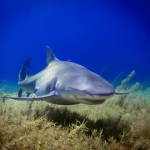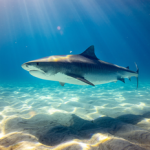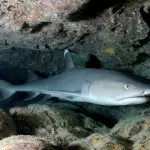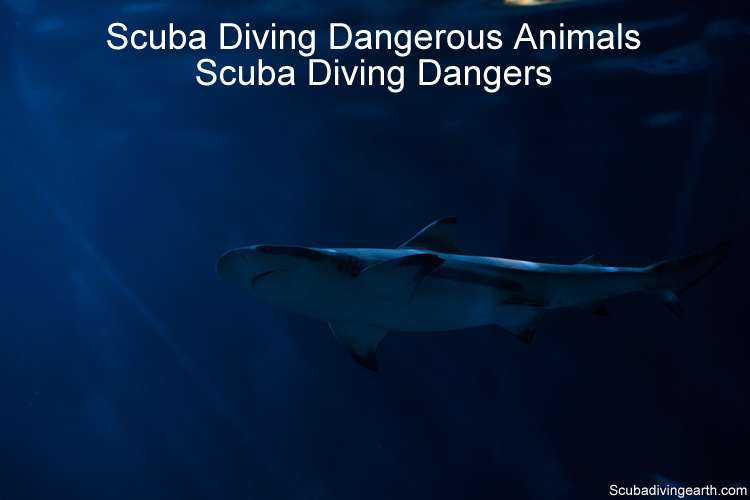
What are the most common scuba diving animal attacks and which are the most dangerous animals underwater
One of the attractions for scuba divers about entering the underwater world is the interaction with nature. It’s that encounter with animals and for many it’s about that encounter with some of the worlds most dangerous animals. But the majority of this ‘danger’ isn’t a real danger at all, but more perceived fear.
Scuba diving with potentially dangerous animals is about respecting the animals and not touching them. But there’s more danger in scuba diving from other things that are not related to dangerous animals. These include scuba diving with health issues, diver errors and equipment failures. But animals that are considered a danger to humans underwater include sharks, barracuda, blue-ringed octopus, scorpion fish, stone fish, lionfish, sea snakes, fire coral, stingrays, jellyfish, flower urchins and cone snails. But in reality, none of these pose a serious threat to scuba divers if treated with adequate respect and caution.
The best way to do more diving, and to discover underwater creatures that will hopefully not attack you, is to book yourself on a scuba diving liveaboard. You can check the latest and best deals on liveaboards using the following window:
What are the dangers of scuba diving?
Before I take a look at scuba diving and dangerous animals, let’s take a look at what are the other dangers to scuba divers.
People often ask ‘what are the dangers of scuba diving?’ There are many dangers to scuba divers, which does include encountering dangerous animals underwater. But the reality is, dangerous animals are low on the list of reasons for scuba diver fatalities.
When I reviewed the Diver’s Alert Network (DAN) report for 2016, which is restricted to scuba divers from America and Canada, of a list of 68 fatalities, non of those were put down to death by dangerous animal. Having said that 40 of the 68 deaths were listed as an unknown cause. But if you look at just the divers from North America, there are over 3,000,000 participants. DAN estimates that 2 out of every 100,000 recreational divers die each year.
In summary this is DAN’s list of causes for scuba diver fatalities:
- Cardiac event 5
- Hypertensive/Atherosclerosis cardiovascular disease 2
- Insufficient breathing gas 5
- Insufficient buoyancy 3
- Natural disease 4
- Out of air 3
- Probable oxygen induced seizure 1
- Rapid ascent 2
- Struck head 1
- Stroke 1
- Unknown 40
Having reviewed the research made on scuba diver deaths, it’s still worth reviewing what animals pose a potential threat to divers underwater. The risks that are posed between scuba divers and dangerous animals, is divers not understanding those risks. Most attacks or injuries are caused from scuba divers provoking wild animals.
Safe diving and the avoidance of injuries from animals that could pose a threat to scuba divers is about education. It’s no different to going on an African safari and walking out into the bush and walking up to a pride of lions. Diving from a liveaboard boat is also referred to as a diving safari, and when you’re on a diving safari you need to respect the sea creatures to find.
You’d be advised to not do that, otherwise you significantly increase your risk of attack.
It would also be like seeing a snake in the wild and picking it up. If you did so, you increase your risk of being bitten, whereas if you kept your distance, respect the wild creature in its natural environment, you can enjoy its beauty and remain safe.
Let’s now take a look at the animals that could pose a threat to scuba divers. What animals are potentially dangerous underwater?
The top of most peoples list is sharks. But in reality, how many scuba divers are attacked by sharks each year?

How many scuba divers are attacked by sharks each year?
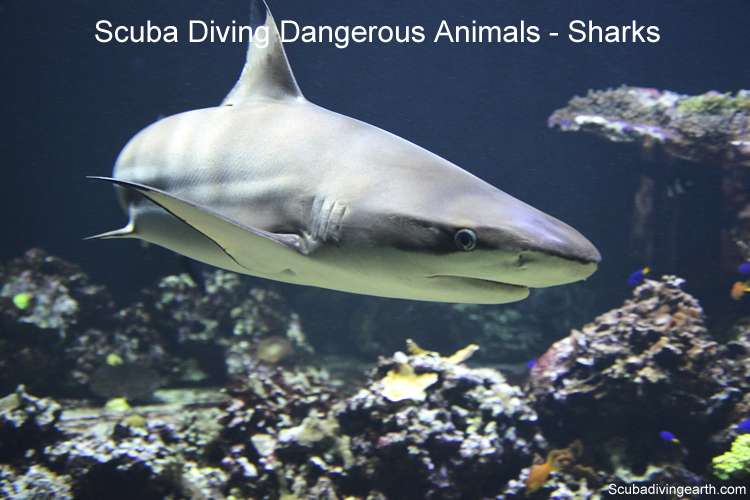
Most people fear sharks, and they are people’s number one fear of animal attacks in water. Aside from those who suffer from a fear of water (or Aquaphobia) and don’t like to enter the sea in any case, the majority would probably put sharks at the top of their fear for not going into the sea.
Of all the potentially dangerous animals in the oceans, sharks seem to have the worst reputation. But in reality, scuba divers are not really at risk from unprovoked shark attacks.
The worldwide total number of unprovoked shark attacks is actually extremely low. This is given the fact that billions of people participate in water-based recreation each year. Which is increasing year on year due to population increases world-wide.
Despite the increased world population, worldwide fatality rates due to shark attacks continue to decline. This decline reflects the advances in beach safety, medical treatment, and public awareness.
In 2017 there were a total of 88 unprovoked shark attacks on people involved with an aquatic activity of one sort or other. But of these it’s not clear whether any of these were scuba divers. But on average around 2% are from unprovoked shark attacks on scuba divers. However, in reality, the risk of a shark attack on a scuba diver is virtually nil. This is taking into account the number of dives completed each year.
Provoked attack vs unprovoked attack by sharks
What I’ve talk about so far is unprovoked shark attacks. Where an unprovoked shark attack is defined as an incident where an attack is made by a shark on a live human, which occurs in the shark’s natural habitat, but with no human provocation of the shark.
Whereas a provoke shark attack occurs when a human initiates physical contact with a shark. Provocation could include for example: a scuba diver is bitten after grabbing, touching or poking a shark. Provoked shark attacks also include attacks on spearfishers and those feeding sharks (which can include scuba divers). Shark bites can also occur with fishermen when they are unhooking or removing a shark from a fishing net.
The way to avoid being attacked by a shark is to not provoke them. Treat sharks like you would a lion or a tiger in the wild. Treat them with a healthy respect and watch-on with interest. Leave them alone and they will leave you alone too.
The other predator lurking in the warms seas is the barracuda. But do barracuda attack divers?
Do barracudas attack divers?
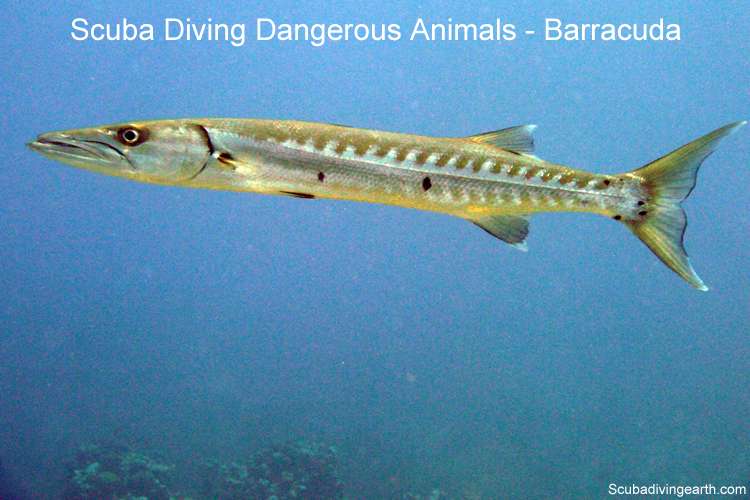
I wanted to ask the question has a barracuda ever killed someone? barracudas certainly look menacing, they are predators and the have teeth. But are they likely to attack a scuba diver?
There are a few types of barracuda and around 20 known species, but they fall into two categories from my perspective. There are the the smaller species, which look a bit like a fresh water pike. But then there’s the much larger great barracuda, which can grow to around 3.66 meters (7 feet) in length.
I remember the first time I spotted a great barracuda. At the time I admit to jumping with a fright when I saw it, as this huge fish came out of the dark on a night dive and was a very close quarters. This was in the Red Sea in Egypt.
I think the problem that many scuba divers face with barracudas, which is possibly why they get the reputation they have, is because they tend to follow divers. They are simply being inquisitive, that’s all.
But there have been apparently a few attacks by barracudas on humans in the water. This might include swimmers, snorkelers and possibly scuba divers. But any attack is likely to be a mistake and it’s very unlikely to happen. Barracudas are attracted to shiny objects, like jewellery. It looks to them like the shiny scales of a small fish, which are their usual prey.
So whilst the great barracuda can be the same size as a human, they are still very unlikely to attack us as prey. The precaution would be to avoid wearing shiny and sparkly jewelry when scuba diving, to avoid the possible mistaken attack by one of these underwater predators.
Other potentially dangerous animals to scuba divers
Aside from the main two animals that most people seem to worry about, like sharks and barracuda discussed above, here’s a list of other dangerous animals to watch out for.
But note, I say watch out for, not stop diving because they are in the water. Or also, please don’t let the fact that these creatures are the underwater stop you from learning to scuba dive either.
Dangerous animals for scuba divers to watch out for
Blue-Ringed Octopus
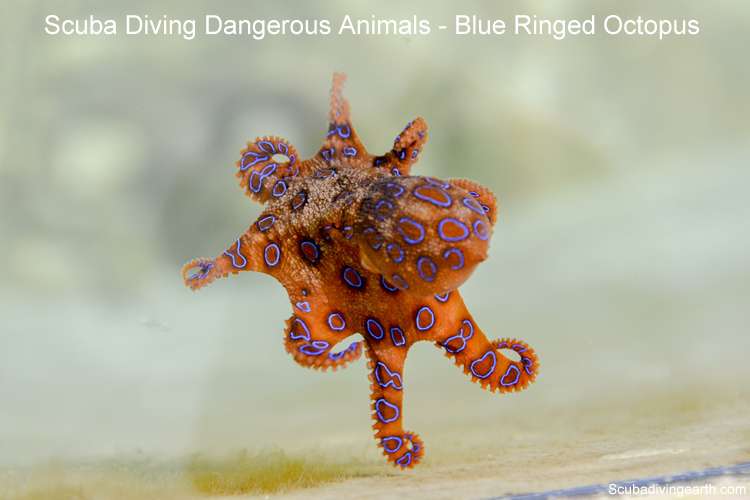
Before I lived in Australia, I’d never heard of the Blue-Ringed Octopus. But I soon discovered how dangerous it is to water users.
My understanding is that it can be found in the rocks and pools around the coast. Mostly in the tidal regions and in the shadows hiding away. It is more of a risk to surfers who walk across the rocks to get to the sea, than it is to scuba divers. If they step on a Blue-Ringed Octopus, it delivers a paralysing dose of venom.
This creature is by far the most dangerous creature you can encounter in the oceans. It is possible to encounter it when scuba diving, but you are totally safe so long as you don’t touch it. Whilst this octopus measures only about 0.2 metre (8 inches) in size, its bite delivers venom to which there is no known antidote.
The blue rings on this beautiful looking creature are quite unmistakable, so if you catch sight of one, the best thing you can do is keep your distance. Do not touch it under any circumstances.
Scorpion fish
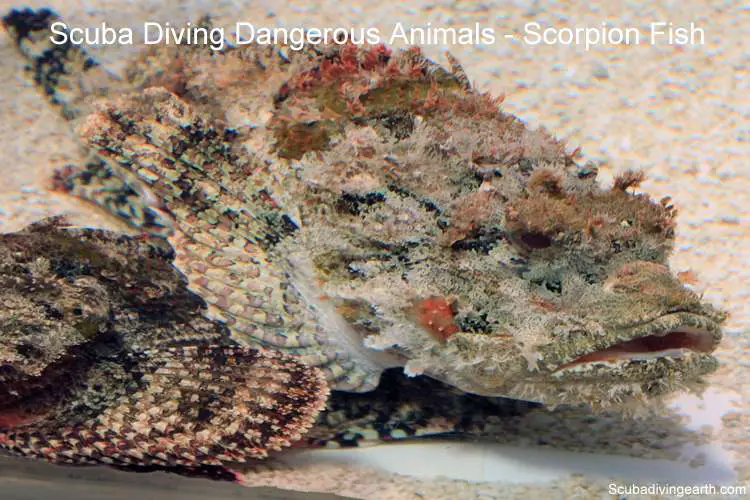
One of the most difficult fish to see in the ocean, apart from stonefish, is the scorpion fish (see below). Quite ugly looking and tending to merge into the background. The scorpion fish is only a dangerous animal due to their extremely sharp dorsal spines. If they are accidentally stood upon or knelt upon, their spines can poke right through your diving gear.
If you’re on your diver descent, and if you intend to touch the bottom on say a sandy bottom, be careful. Before you touch the sand, have a good scout around for any objects that look a bit like a barnacled rock. See the picture above.
Watching out for scorpion fish can be extremely tricky as they’re very good at disguising themselves. The trouble is they many times bury themselves in the sand. So sometimes you’ll not even spot they are there.
It is therefore recommended that you resist the temptation to settle on a sanding bottom in and around the coral seas, like the Caribbean, the Red Sea, the Pacific Ocean, Australian and Hawaii. This is just one of the many reasons why controlling your buoyancy is one of the keys to safe scuba diving.
The the venom in their spines can cause extreme pain, but is unlikely to be fatal. However, this could because fatal if you have an extreme allergic reaction to the poison. Therefore, be on the lookout as you explore and like all wild or potentially dangerous creatures, do not touch them.
Stone fish
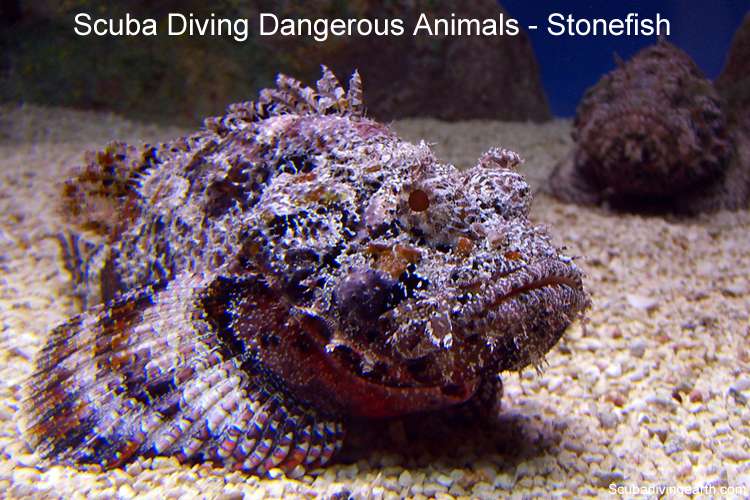
The stone fish is very similar to the scorpion fish and is part of the same family or species of fish known as Scorpaenidae, which also includes lionfish – see below.
The stonefish is the worlds most venomous fish. Like scorpion fish, the stonefish is also extremely well camouflaged and is found in the waters of northern Australia.
Like their cousin the scorpion fish, it’s their dorsal spines that contain the venom. But this venom is only released or injected when external pressure is applied. Like for example, if a bather were to stand on one. Or in our case, as a scuba diver accidentally stepping or kneeling on one.
These fish do not go out of their way to attack scuba divers. These fish are ‘innocent stingers,’ but the problem is that the sting can become fatal to humans.
They are extremely difficult to spot because they usually bury themselves under sand or rubble. They usually only leave their eyes showing above the same. This means that the venomous spines will be hidden too.
But even if they are out in the open they are still difficult to spot then, as often algae and hydroids grow on their backs.
Lion fish
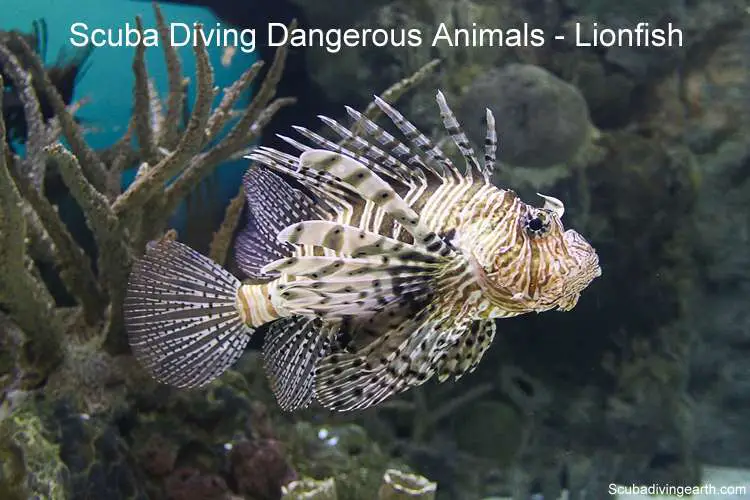
As noted above, lionfish are a Scorpaenidae type fish. As with the scorpion fish and the stonefish, lionfish also have venomous spines.
But also, just like their cousins, they are only ever dangerous if the spines are touched. But it’s unlikely the sting of a lionfish would be fatal, but in any event you should only watch and not touch.
Having said that, the lion fish in the Caribbean are causing havoc. They are not native to the Caribbean and as such they are being killed and destroyed by scuba divers. If you decide to participate in this culling process when you’re diving in the Caribbean, be careful not to touch the lionfish’s spines.
Sea snakes
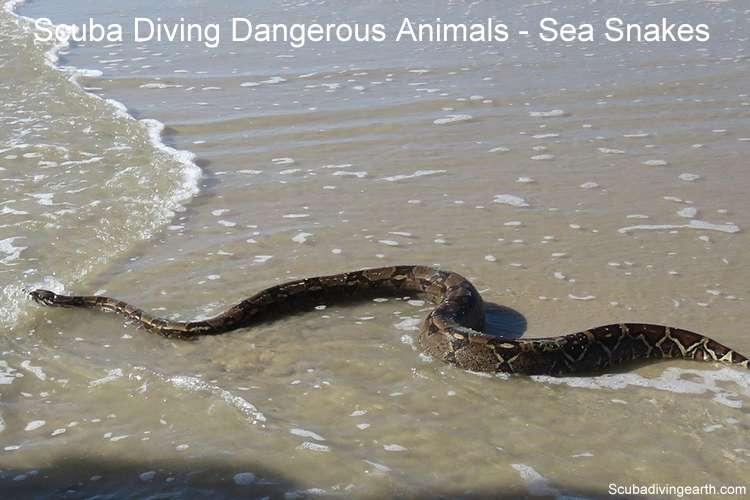
Like all underwater creatures, sea snakes are no different. If you don’t interfere with them, then they won’t harm you either. The same rules apply to snakes underwater, i.e. sea snakes, as they do if you spot a snake on land. This rule is leave well alone, do not touch and stay clear. That way you can enjoy their beauty and not be at danger of being bitten by one.
Sea snakes can be quite inquisitive though. That may be a problem if you don’t like snakes. I’ve had a few sea snakes swim around me and under me, some as long as 3 metres (10 feet) in length. The longest sea snakes I encountered were in Western Australia on the Ningaloo Reef. These were big long yellow snakes. Most of which were curled up asleep on the sand.
Sea snakes are like land snakes, but have a similarity to eels, as they tend to have a more flattened body to help them propel themselves through the water. Also, their bite can be more venomous than land snakes, but they aren’t prone to aggression unless aggravated. So as always don’t touch and if one does swim up to you, let it ‘check you out’ and it will swim away again and will not attack you.
Stinging coral or fire coral
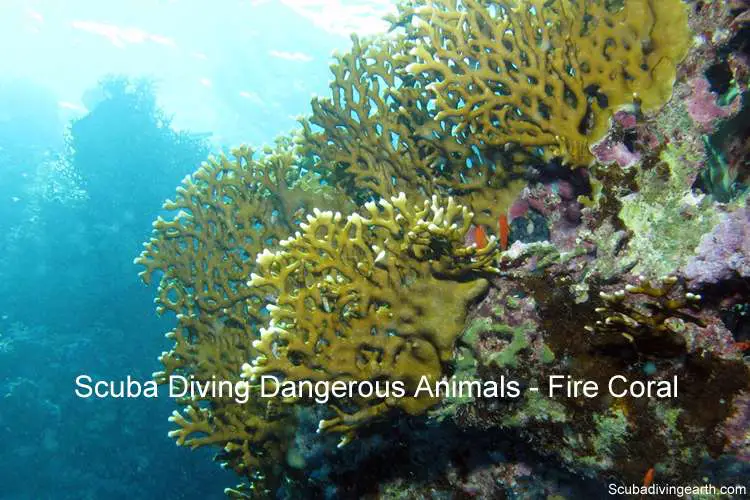
As we all know, coral is beautiful in colour, but never be tempted to touch. Not only could you damage the reef, but if it’s fire coral it will burn you. I’ve accidentally touch fire coral a couple of times. It’s like being stung by stinging nettles or poison ivy.
Fire coral or also known as stinging coral, is mostly brown or bright yellow-green. The sting from fire coral can cause anything from what I got, which was a mild to strong skin irritation. But in worst cases it can lead to nausea and vomiting.
There are other stinging corals, which are harder to identify than fire coral, so as always it’s best to not touch coral in any case. If you do it cause a great deal of damage.
Stingrays
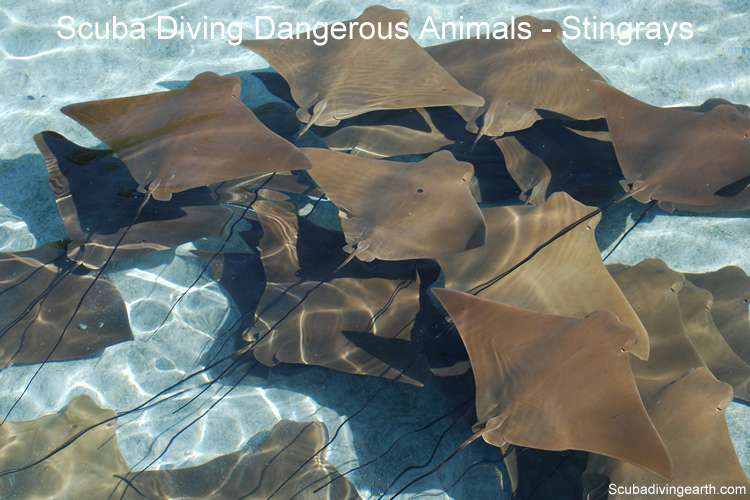
When I think about stingrays and the danger they pose to scuba divers or snorkelers, I can’t help but thing of Australian explorer and Zookeeper Steve Irwin. I loved to watch Steve Irwin, as he was probably one of the most enthusiastic wildlife presenters there’s ever been. I almost couldn’t believe the news when I heard that he’d be killed by a stingray.
Steve Irwin was a larger than life character, who always pushed the boundaries. This applied to land creatures as well as aquatic creatures. These encounters even include salt water crocodiles.
I guess it was only a matter of time when one of these creatures would get him. I thought it would be a snake, as he was always tackling venomous snakes on his programs.
But it was a stingray that got him in the end. Irwin died on 4 September 2006 after being pierced in the heart by a stingray barb. At the time ironically he was filming an underwater documentary film titled Ocean’s Deadliest.
The moral of the story, like all the other potentially dangerous creatures listed in this article, is to keep your distance and don’t touch. Obviously Steve Irwin got too close and the stingray was simply defending itself.
All you need to do to be safe around stingrays is to keep a safe distance and don’t touch them. But in particular stay clear of their tail, which is where the venomous barb is located.
Jellyfish
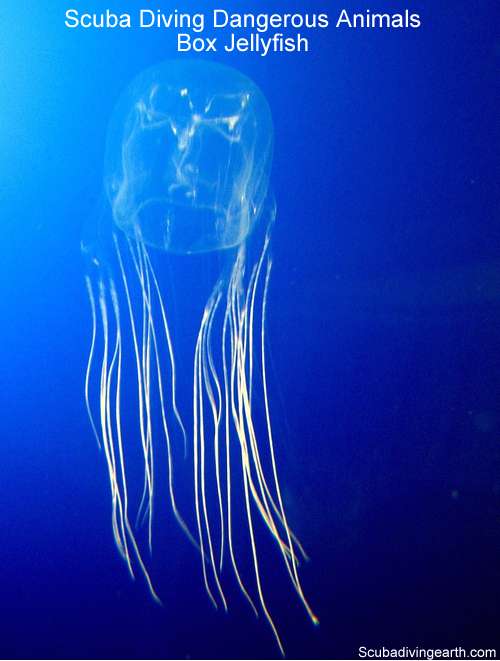
There are many species of jellyfish in the sea. Some are completely harmless to divers and other water users, whilst others can be deadly.
Others can cause mild irritation, whilst the two described in this article can cause serious injury or can also be fatal. The most dangerous species of jellyfish include Box jellyfish and the Portuguese Man o’ war (also known as man of war).
Both of these can deliver an extremely painful sting. But in both cases this sting can also be fatal too. Which for the box jellyfish is because its venom affects the nervous system and heart.
The box jellyfish are found in northern Australia and is also known as the ‘sea wasp.’ The man o’ war is found in the Atlantic, Indian and Pacific Oceans.
Flower urchins
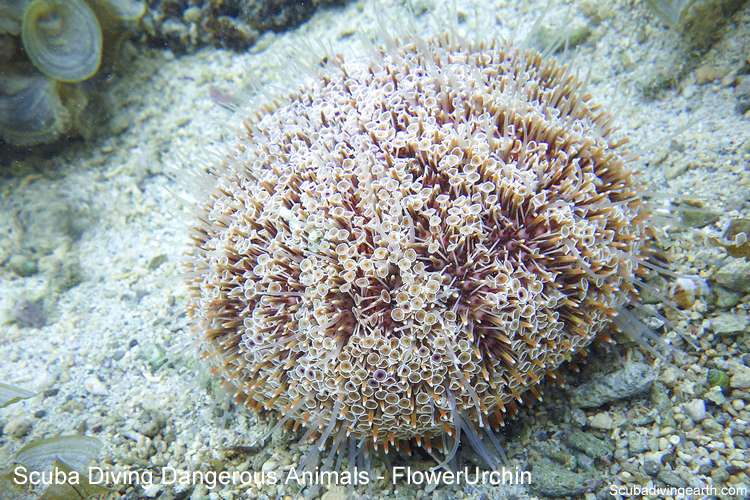
Flower urchins are widespread and found in the Indo-West Pacific Ocean.
The flower urchin is considered highly dangerous because it’s capable of delivering an extremely painful and medically significant sting if touched.
Cone snail
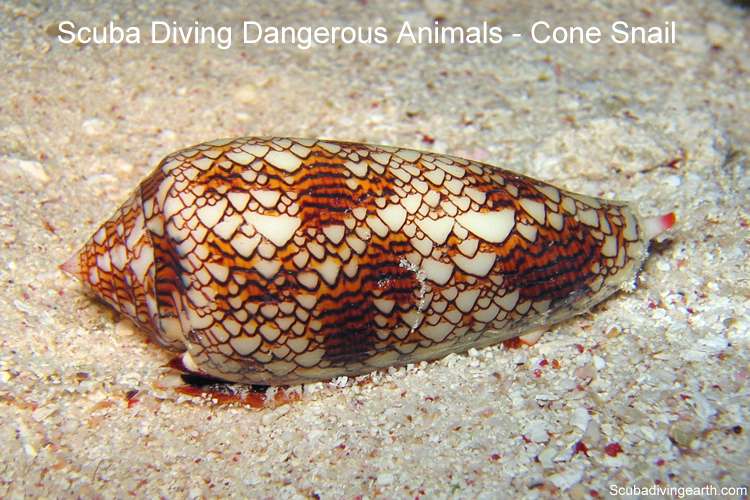
There are many species of cone snail and are known to be venomous.
Because all cone snails are venomous and capable of “stinging” humans, live ones should never be handled, as their venomous sting will occur without warning and can be fatal.
The species of cone snail that are most dangerous to humans are the larger cones. These are the ones which prey on small bottom-dwelling fish.
The problem that occurs with a cone snail is that snorkelers or divers find one and think it’s a a shell to collect. Many times an unsuspecting snorkeler or diver has put a live cone snail in their pocket by mistake. What can happen is the live snail comes out of it’s shell and stabs the person with its venomous spike or hypodermic needle.
If you spot one, leave well alone and you’ll be safe.
I hope you enjoyed this article about scuba diving dangerous animals
I’d love to hear from you. Tell us about your adventures of diving and snorkeling, in the comments below. Please also share your photos. Either from your underwater cameras or videos from your waterproof Gopro’s!
If this article hasn’t answered all of your questions. If you have more questions either about snorkeling or scuba diving (or specifically about scuba diving dangerous animals), please comment below with your questions.
There will also be many more articles about scuba diving (and snorkeling) for you to read and learn about these fabulous sports.
Have fun and be safe!

